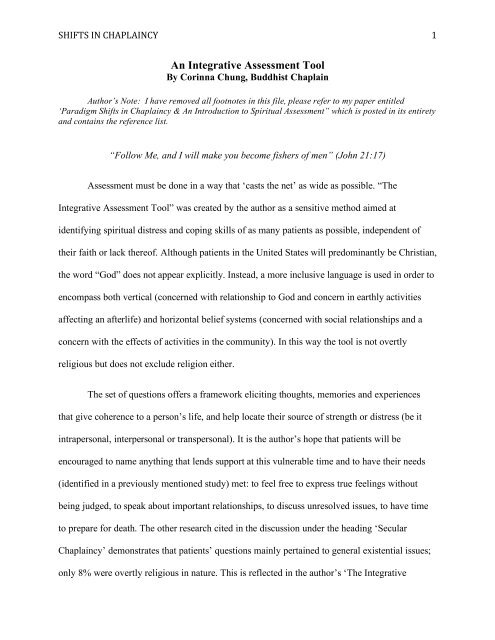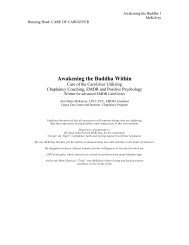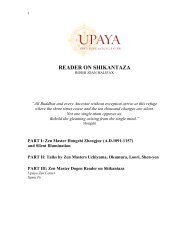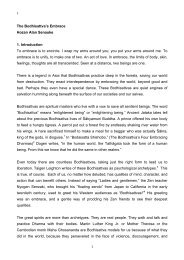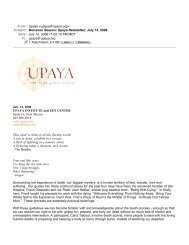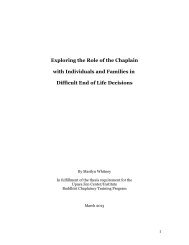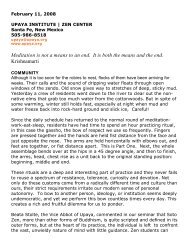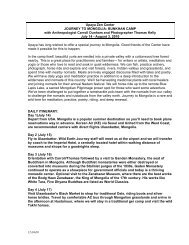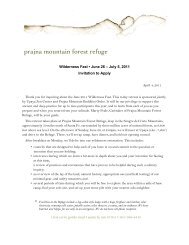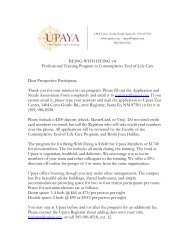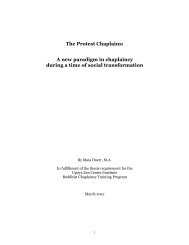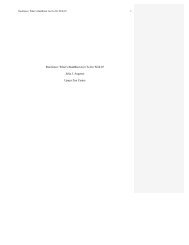Integrative Assessment Tool - Upaya Zen Center
Integrative Assessment Tool - Upaya Zen Center
Integrative Assessment Tool - Upaya Zen Center
You also want an ePaper? Increase the reach of your titles
YUMPU automatically turns print PDFs into web optimized ePapers that Google loves.
SHIFTS IN CHAPLAINCY 1<br />
An <strong>Integrative</strong> <strong>Assessment</strong> <strong>Tool</strong><br />
By Corinna Chung, Buddhist Chaplain<br />
Author’s Note: I have removed all footnotes in this file, please refer to my paper entitled<br />
‘Paradigm Shifts in Chaplaincy & An Introduction to Spiritual <strong>Assessment</strong>” which is posted in its entirety<br />
and contains the reference list.<br />
“Follow Me, and I will make you become fishers of men” (John 21:17)<br />
<strong>Assessment</strong> must be done in a way that ‘casts the net’ as wide as possible. “The<br />
<strong>Integrative</strong> <strong>Assessment</strong> <strong>Tool</strong>” was created by the author as a sensitive method aimed at<br />
identifying spiritual distress and coping skills of as many patients as possible, independent of<br />
their faith or lack thereof. Although patients in the United States will predominantly be Christian,<br />
the word “God” does not appear explicitly. Instead, a more inclusive language is used in order to<br />
encompass both vertical (concerned with relationship to God and concern in earthly activities<br />
affecting an afterlife) and horizontal belief systems (concerned with social relationships and a<br />
concern with the effects of activities in the community). In this way the tool is not overtly<br />
religious but does not exclude religion either.<br />
The set of questions offers a framework eliciting thoughts, memories and experiences<br />
that give coherence to a person’s life, and help locate their source of strength or distress (be it<br />
intrapersonal, interpersonal or transpersonal). It is the author’s hope that patients will be<br />
encouraged to name anything that lends support at this vulnerable time and to have their needs<br />
(identified in a previously mentioned study) met: to feel free to express true feelings without<br />
being judged, to speak about important relationships, to discuss unresolved issues, to have time<br />
to prepare for death. The other research cited in the discussion under the heading ‘Secular<br />
Chaplaincy’ demonstrates that patients’ questions mainly pertained to general existential issues;<br />
only 8% were overtly religious in nature. This is reflected in the author’s ‘The <strong>Integrative</strong>
SHIFTS IN CHAPLAINCY 2<br />
<strong>Assessment</strong> <strong>Tool</strong>’. At the same time ‘The <strong>Integrative</strong> <strong>Assessment</strong> <strong>Tool</strong>’ covers what Stoll<br />
describes as the four essential areas for spiritual assessment:<br />
1. Concept of God/transcendence<br />
2. Source of hope and strength<br />
3. Religious practices<br />
4. Relationship between spirituality and health<br />
On one hand, the set of questions in ‘The <strong>Integrative</strong> <strong>Assessment</strong> <strong>Tool</strong>’ help the chaplain<br />
to effectively collect objective data, such as faith denomination and the impact of the patient’s<br />
faith on medical care. On the other hand, and in contrast to most existing tools known to the<br />
author, ‘The <strong>Integrative</strong> <strong>Assessment</strong> <strong>Tool</strong>’ focuses on deeper, more subjective data. The different<br />
sets of questions provides a framework for the chaplain and the patient to explore the two basic<br />
categories of spiritual assessment 44 :<br />
1. Functional information, the ‘How’ of spiritual life, because most people can relate<br />
to these common human quests, even if the patient has found no answers:<br />
(cognitive) search for meaning/ purpose;<br />
(experiential) feeling hope/joy/peace/comfort;<br />
(relational) relationship between health and beliefs/practices; relationship to<br />
family/ friends/ community; coping skills.<br />
2. Substantive information, the ‘What’ of spiritual life:<br />
past spiritual/religious background and present spiritual/religious affiliation;<br />
beliefs about self/others/ transcendence;
SHIFTS IN CHAPLAINCY 3<br />
present personal practices, rituals, faith community;<br />
the level of involvement/support they provide. 44<br />
The ‘<strong>Integrative</strong> <strong>Assessment</strong> <strong>Tool</strong>‘ also contains a section for palliative care patients to<br />
facilitate end-of-life planning, once a patient has reached the level of acceptance that allows<br />
addressing these issues directly. The set of questions aid the chaplain and patient to explore<br />
subjects such as end of life reaction, terminal event arrangements, afterlife beliefs and<br />
reconciliation with self/others/Spiritual Source.<br />
Instruction to the Chaplain on how to use ‘The <strong>Integrative</strong> <strong>Assessment</strong> <strong>Tool</strong>’:<br />
• Chaplains can use ‘The <strong>Integrative</strong> <strong>Assessment</strong> <strong>Tool</strong>‘ as a guide to support them<br />
in conducting semi-structured interviews. Not all questions have to be asked; they<br />
represent available options for the chaplain to invite reflections, memories and<br />
stories, slowly mapping this individual’s resources and the barriers to using them.<br />
• The author assumes the religious denomination has already been determined<br />
during the screening protocol. This information, together with answers about faith<br />
community and who the patient would like to contact to talk with about religious<br />
or other matters, will come up naturally as the chaplain poses the questions that<br />
explore resources and how the patient finds meaning.<br />
• Besides establishing rapport and trust in whatever way is appropriate, chaplains<br />
need to determine how best to preface the questions themselves. For example, by<br />
beginning with “If you are comfortable talking about this topic, would you please<br />
share some of your beliefs about…”.
SHIFTS IN CHAPLAINCY 4<br />
• With minor modifications (not included here) ‘The <strong>Integrative</strong> <strong>Assessment</strong> <strong>Tool</strong>‘<br />
can be used for assessing family, friends or medical staff. It is of course crucial to<br />
follow up, explain, reassure and counsel the patient’s loved ones.<br />
• While with the patient, it is recommended to keep note-writing to a minimum in<br />
order to give as much undivided attention as possible to the patient. Even if notes<br />
have to be made, the chaplain aspires to provide an atmosphere of communion<br />
rather than that of an interview.<br />
Listen to where resources stem from / who or what gives meaning; listen to what might be<br />
source of distress; listen to clues for effective interventions:<br />
1. intrapersonal / self: recognition of positive traits, healthy self-esteem in spite of physical<br />
disabilities, being in touch with oneself, quiet time, ability to relax, ability to tolerate stress,<br />
ability to endure loss/vulnerability/uncertainty/ambiguity, accepts and embraces the impossibility<br />
to find meaning, completion of tasks, finished business, feels involved in decision-making, has<br />
some degree of control, positive outlook, gratitude, forgiveness.<br />
2. interpersonal / relational: love, sense of belonging, closeness, closure with others,<br />
significant other, family, friends, pets, social networks, fellowship – spiritual, cultural,<br />
professional or other.<br />
3. transpersonal / religious / contemplative: God, deities, ultimate reality, sense of the sacred,<br />
set of values, connectedness with or feeling looked after by Higher Power, surrender into God’s<br />
hands, sacred scriptures, sacraments, spiritual community, clergy, faith, worship, hymns, prayer,<br />
guided imagery, meditation, spiritual/religious practices, rituals.
SHIFTS IN CHAPLAINCY 5<br />
4. environmental / creative / therapeutic: experience nature, music, literature, poetry, beauty,<br />
creating collage or other art projects, journal-keeping, life review.<br />
THE QUESTIONS:<br />
(a) Securing and Strengthening Resources<br />
(past – coping skills)<br />
How has your attitude to life, spirituality or religion sustained you<br />
during difficult times in the past?<br />
What in your life has brought you joy or peace?<br />
(present - resources)<br />
What could nurture your inner strength or your spirit while you are here?<br />
How does your faith, relationships or other resources you have, help you during this illness?<br />
What can I do to make you feel more comfortable?<br />
(future – retaining hope / goal setting)<br />
What inspires you with hope?<br />
What kind of goals do you look forward to? (consider short, medium and long-term goals)<br />
(b) Opening to a higher perspective/Finding meaning<br />
(past)<br />
Looking back over your life, what moments, people or experiences stand out as important?
SHIFTS IN CHAPLAINCY 6<br />
What did you consider the most meaningful things in life?<br />
(present)<br />
What really matters to you now?<br />
What helps you make sense of being here?<br />
How has your relationship changed to important things in your life?<br />
Where does your sense of what to do, or how to look at things come from?<br />
(future)<br />
What is important for you to happen in the next few days or weeks?<br />
What would help you find peace of mind?<br />
What do you wish for?<br />
(c) Impact on Medical Care and Decision Making 46<br />
How do your beliefs influence the way you think about your health?<br />
How do your beliefs influence how you look at your disease?<br />
How do your beliefs impact your decisions about your treatment and medical care?<br />
What would you like your caregivers to know and pay special attention to?<br />
(d) Special Considerations<br />
TV on/off, curtains open/closed, lights bright/soft, temperature higher/lower, frequency of<br />
visitors more/less, display of religious or cultural symbols, personal photo frames, flowers, wall
SHIFTS IN CHAPLAINCY 7<br />
decoration, special blanket and other personal items, CD player, DVD player, writing or art<br />
supply, room with a view of sky/mountains if desired and possible.<br />
(e) Cultural / Interfaith Considerations<br />
Interfaith and cultural considerations become particularly important toward end of life and<br />
require awareness of the chaplain’s own ethnocentricity. Although it is unrealistic to expect a<br />
chaplain to be fully competent at intercultural communication skills and to know the customs,<br />
taboos, etc. of all cultures, an effort in behavioral flexibility and interfaith education has to be<br />
made to avoid major missteps. It might be helpful to solicit the patient/their loved ones as<br />
teachers regarding faith/cultural practices by saying, for example, “I am not very familiar with<br />
your culture / faith, could you help me understand…”.<br />
(f) End of life Planning<br />
Terminal event planning is intended for patients with grave illnesses. It can only be undertaken if<br />
the patient / family is not overwhelmed by the fear of dying and has reached a sufficient level of<br />
acceptance of dying.<br />
Care:<br />
How do your beliefs impact your hospital care, treatment or medical procedures?<br />
What aspects of your religion or spirituality might impact how you would like<br />
– or would not like to be cared for?<br />
Do you have an advanced directive to let caregivers know what treatments you wish them to<br />
withhold?
SHIFTS IN CHAPLAINCY 8<br />
What would you like your caregivers to know and pay special attention to?<br />
Regrets / Forgiveness / Closure:<br />
What do you feel you have lost in the course of this illness?<br />
Is there any kind of “unfinished business” you would feel comfortable sharing with me?<br />
If you had your life to live over – what would you like to be the same<br />
and what would you like to have done differently?<br />
In terms of your relationships (or whatever issue causes distress) – what would you like to be the<br />
same and what would you like to have done differently?<br />
Whose visit would mean a lot to you now?<br />
Are there people you would like me to contact for you now, even if you have not seen them in a<br />
long time? (For example, to say that you forgive them, or to ask for their forgiveness 69 )<br />
Are there people who you would like to call and come visit<br />
(so that you can say ‘good-bye’ and ‘I love you’ 69 )?<br />
How can I support you in finding a sense of closure as you approach the end of your life?<br />
Even if your body should not get cured, what would help you now to find peace of mind?<br />
Life review<br />
What would you say were ‘the milestones’ in your life?<br />
Would you be interested in drawing or writing a timeline of your life (or spiritual history)<br />
including remarkable encounters and important events?
SHIFTS IN CHAPLAINCY 9<br />
Some say “wisdom is what floats to the top like cream after a rich life” – What kind of wisdom<br />
or legacy would you like to share or leave behind for others?<br />
Would you like to tell me about X as a person?<br />
Preparation:<br />
Where would you like to die?<br />
What does death mean to you?<br />
What does it mean to you that this is happening?<br />
Actual death:<br />
What is important about how others will care for your body before and after you die?<br />
What is important about how others conduct themselves at time of your death?<br />
What specific instructions do you have about the care of your body after you die?<br />
Funeral arrangements:<br />
Where and how would you like to be buried or cremated?<br />
What kind of ritual or funeral service would you choose?<br />
Is there someone special you would like to officiate?<br />
Is there something special you would like to be said at your funeral?<br />
After death / Afterlife:<br />
How do you want to be remembered?<br />
What do you believe happens after death?
SHIFTS IN CHAPLAINCY 10<br />
If your health should decline, how does your faith - or other resources -<br />
prepare you for what is ahead?<br />
Palliative Care Chaplaincy<br />
The historical relationship between spiritual and palliative care goes back to the Middle<br />
Ages when monasteries offered hospitium, a safe resting place for weary, and sometimes dying,<br />
travelers. The ancient monks’ mission was to save souls. Although today’s standards of spiritual<br />
care reflect the changes the role of chaplain has undergone over the centuries, the mission of<br />
palliative care – of which spiritual care is an important component - remain the same: to make<br />
dying easier.<br />
The medical profession still treats its role as an art as much as a science, relying on<br />
philosophical principles like the rule of double effect, attributed to the 13 th century<br />
Roman Catholic philosopher Thomas Aquinas. Even if there is a foreseeable bad<br />
outcome, like death, it is acceptable if it is unintended and outweighed by an intentional<br />
good outcome – the relief of unyielding suffering before death.<br />
To avoid misunderstanding, it has to be said that most comfort measures do not hasten<br />
death in any way. Because of the comfort palliative care can provide, patients’ requests for<br />
euthanasia diminish. Spirituality is a dimension of palliative care, and spiritual well-being, too,<br />
stands in inverse relationship with desire for hastened death, suicidal ideation and hopelessness.<br />
Research has already been cited that demonstrates religion and spirituality to be a crucial coping<br />
skill protecting the patient against end-of-life despair, and that spiritual care greatly comforts
SHIFTS IN CHAPLAINCY 11<br />
terminal patients. Even though, as discussed previously, some people’s interpretation of doctrine<br />
can also cause spiritual pain to arise.<br />
One provision of the House health care bill passed in November 2009 recognizes that<br />
palliative care may include treatment “furnished for the purpose of alleviating pain or<br />
discomfort, even if the use may increase the risk of death.” Constant vigilance concerning abuse<br />
is appropriate, for example to monitor whether terminal sedation is administered because of<br />
pressure from family, economic reasons or simply out of convenience. In their recommendations,<br />
the Institute for Healthcare Improvements (IHI) lists “learn how to provide care that is death<br />
accepting” as optimum practice. Ars moriendi, ‘the art of dying’ (a term originating in the<br />
Middle Ages) in modern times could refer to palliative care efforts to restore death to its sacred<br />
or significant place, in contrast to it being a technological or management issue. Florence<br />
Nightingale reintroduced the notion of holistic care in the 19 th century.<br />
The Sisters of Charity, the same Order that established St. Vincent in New Mexico in<br />
1865, opened the first hospices in Ireland and France. Dame Cicely Saunders was a key figure<br />
from the 1940’s onward and pioneered the hospice movement in England. In the USA Elizabeth<br />
Kubler-Ross captured the interest of a large lay audience with her research on the stages of<br />
dying. Between 1986 and 1996 the Elizabeth Kubler-Ross Institute in El Rito was part of the<br />
Northern New Mexico College. For linguistic reasons, the French Canadians chose to name their<br />
hospice service in Montreal ‘palliative’ care when it was established in 1974 (palliative from<br />
Latin palliare, to cloak or cover; care that palliates, i.e. alleviates or relieves suffering).<br />
The author’s ‘<strong>Integrative</strong> <strong>Assessment</strong> <strong>Tool</strong>’ contains an ‘end-of-life planning’ section. It<br />
takes into consideration the particular concerns of palliative care patients and helps the chaplain
SHIFTS IN CHAPLAINCY 12<br />
to address them in a sensitive manner. Palliative care chaplains explore the patient’s/their loved<br />
one’s beliefs about death and afterlife, how these affect medical decisions, such as organ<br />
donation and blood transfusion. They may have to lend their support to discuss an advanced<br />
medical directive, including DNR (Do Not Resuscitate order), and the patient’s preferred site of<br />
death.<br />
Besides assuring the collection of essential information, the ‘<strong>Integrative</strong> <strong>Assessment</strong><br />
<strong>Tool</strong>’ could also point out areas a chaplain avoids consciously or unconsciously, because of<br />
his/her own unease with the subject. This can occur due of a lack of self-knowledge, for<br />
example, if chaplains have not explored their own hopes and fears about what a ‘good death’ or<br />
‘bad death’ might mean for them; attitude and issues concerning mortality, loss of control, etc.<br />
Self-knowledge is an essential prerequisite for a chaplain to use assessment tools in general and<br />
in palliative care in particular.<br />
Many examples of empirical research studies have already been cited in this document<br />
showing that patients, especially those in palliative care, feel spirituality is one of the most<br />
important contributors to their quality of life and strongly desire it to be included in their care.<br />
Further research affirms that questions of a spiritual nature - Who am I? Is there a meaning to<br />
life? - arise around the teenage years and stay prevalent into the early 20s. They are mostly put<br />
aside when time and energy is dedicated to building a career and founding a family. However,<br />
these concerns resurface and become a vital focus again when a life threatening illness is<br />
diagnosed or a person approaches the end of their life. This renewed urge to reconnect to one’s<br />
spiritual ‘roots’ and to explore these profound questions has to be satisfied by chaplains being<br />
integral part of all interdisciplinary palliative care teams.
SHIFTS IN CHAPLAINCY 13<br />
The chaplain’s presence could be of pivotal importance for people who experience the<br />
crisis as an opportunity for spiritual healing, growth or transformation. Both the spiritual and<br />
psychosocial dimensions of dying are within the scope of a chaplain. Most patient benefit from<br />
support in dealing with end of life reactions, including: anger, feeling like a burden, the change<br />
and loss of virtually everything familiar and dear, self-image, social station etc., issues of<br />
forgiveness and reconciliation with oneself, an estranged friend / family member / Spiritual<br />
Source. All these are prominent needs and exploring them might well be a prerequisite for being<br />
at peace and dying in peace.<br />
Early referral is a major factor in successful intervention. It takes time to establishing<br />
rapport and trust. One of the most important things a chaplain can convey is that he/she is not in<br />
a hurry, that this meeting is the most important and precious thing to do at this moment. As<br />
discussed under the heading ‘Dangers of Interpretation’, a person’s interpretation of religious<br />
doctrine can also be the cause of spiritual struggle. Exploring spiritual pain is not done quickly.<br />
Dame Cicely Saunders concept of ‘total pain’ emphasizes that the patient’s mood, morale and<br />
the meaning pain has for the patient all modulates the experience of pain. Spiritual interventions<br />
such as gathering of loved ones the patient wishes to take leave of; finding closure through<br />
reconciliation; a life review, spiritual genogram and other creative tools for the reframing or<br />
renovation of experience all take time and must not be rushed. Yet, decline is often rapid, as in<br />
advanced cancer, and energy and clarity of mind are quickly lost; functioning becomes slower<br />
and spiritual work might become difficult to master.<br />
Most Americans would prefer to die at home, but an analysis of Medicare recipients<br />
shows that up to 85% die in hospitals or nursing homes. In hospital settings medical staff is often<br />
pressured by understaffing, limited budget and management demands. If not trained in end-of -
SHIFTS IN CHAPLAINCY 14<br />
life care, a professional attitude to medical care could mean one that is based on facts, but does<br />
not necessarily consider the emotional impact of giving bad news for example. The conventional<br />
curative model places emphasis on technology, quantity of life, curing at any cost. Patients, even<br />
when close to death, might still be intubated, ventilated and monitored by machines. The<br />
palliative model and holistic medicine integrate spiritual care and promote a person-centered<br />
approach. This means services are people oriented, centering the patients’ experience more in<br />
terms of human relationships and quality of life, rather than only medical and physiological<br />
issues. With holistic care it is possible for a dying patient to feel comfortable and experience<br />
healing, even if the illness cannot be cured.<br />
As previously mentioned studies have demonstrated, prevalent needs of palliative care<br />
patients include: to have time to think, to resolve ‘unfinished business’ and to prepare for death.<br />
There does not seem any reason to delay referrals other than misconceptions about the role and<br />
function of palliative care of which spiritual care is a very important component. In recent public<br />
debates over the House health care bill, which allows doctors to be reimbursed for discussions<br />
with patients about what treatments they would want or decline, some Republicans charged that<br />
‘death panels would decide who deserves to live or die’. Another misunderstanding is that not<br />
prolonging life artificially equals euthanasia. In fact, providing high quality palliative care,<br />
including pain management and spiritual care, results in patients feeling more comfort and the<br />
wish for a hastened death diminishes.<br />
Considering that the average stay of people in hospice unfortunately still only averages<br />
one week, it is imperative to continue educating medical staff about why early referrals. A<br />
chaplain recognizes when the moment it is not right and will not impose his/her visit, and it is<br />
always hoped that patients will graduate from hospice. It also impacts the patient’s family and
SHIFTS IN CHAPLAINCY 15<br />
friends because bereavement support needs to start prior to the death of the patient. Family can<br />
also benefit by trained chaplain assisting them to make difficult decisions by being coached in<br />
the 4 bases of ethical decision-making: autonomy, non-maleficence, beneficence and justice. An<br />
optimal practice for Christus St. Vincent would be a as a matter of course to include a chaplain’s<br />
visit to all palliative care patients on a daily basis, and to continue offering education on the<br />
benefits of both palliative and spiritual care.


